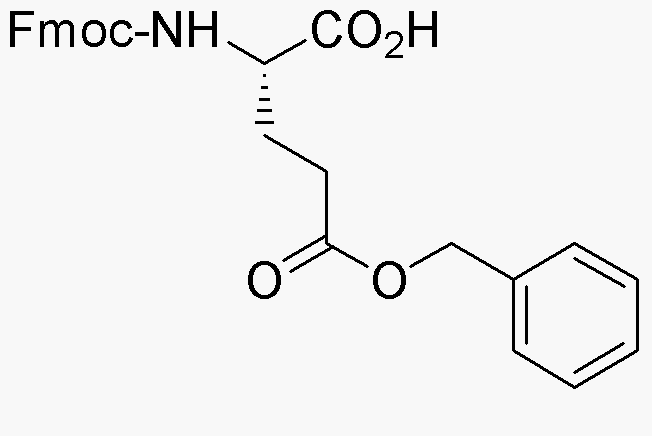Fmoc-L-glutamic acid g-benzyl ester is widely utilized in research focused on:
- Peptide Synthesis: This compound serves as a key building block in the synthesis of peptides, allowing researchers to create complex protein structures efficiently.
- Drug Development: It plays a crucial role in the pharmaceutical industry, particularly in developing new drugs that target specific biological pathways, enhancing therapeutic efficacy.
- Bioconjugation: The compound is used in bioconjugation processes, enabling the attachment of biomolecules to surfaces or other molecules, which is essential in diagnostics and therapeutic applications.
- Research in Neuroscience: Its derivatives are often employed in studies related to neurotransmitter signaling, helping scientists understand brain function and develop treatments for neurological disorders.
- Material Science: The compound is also explored in creating advanced materials, such as hydrogels, which have applications in drug delivery systems and tissue engineering.
General Information
Properties
Safety and Regulations
Applications
Fmoc-L-glutamic acid g-benzyl ester is widely utilized in research focused on:
- Peptide Synthesis: This compound serves as a key building block in the synthesis of peptides, allowing researchers to create complex protein structures efficiently.
- Drug Development: It plays a crucial role in the pharmaceutical industry, particularly in developing new drugs that target specific biological pathways, enhancing therapeutic efficacy.
- Bioconjugation: The compound is used in bioconjugation processes, enabling the attachment of biomolecules to surfaces or other molecules, which is essential in diagnostics and therapeutic applications.
- Research in Neuroscience: Its derivatives are often employed in studies related to neurotransmitter signaling, helping scientists understand brain function and develop treatments for neurological disorders.
- Material Science: The compound is also explored in creating advanced materials, such as hydrogels, which have applications in drug delivery systems and tissue engineering.
Documents
Safety Data Sheets (SDS)
The SDS provides comprehensive safety information on handling, storage, and disposal of the product.
Product Specification (PS)
The PS provides a comprehensive breakdown of the product’s properties, including chemical composition, physical state, purity, and storage requirements. It also details acceptable quality ranges and the product's intended applications.
Certificates of Analysis (COA)
Search for Certificates of Analysis (COA) by entering the products Lot Number. Lot and Batch Numbers can be found on a product’s label following the words ‘Lot’ or ‘Batch’.
Numéro de catalogue
Numéro de lot/série
Certificates Of Origin (COO)
This COO confirms the country where the product was manufactured, and also details the materials and components used in it and whether it is derived from natural, synthetic, or other specific sources. This certificate may be required for customs, trade, and regulatory compliance.
Numéro de catalogue
Numéro de lot/série
Safety Data Sheets (SDS)
The SDS provides comprehensive safety information on handling, storage, and disposal of the product.
DownloadProduct Specification (PS)
The PS provides a comprehensive breakdown of the product’s properties, including chemical composition, physical state, purity, and storage requirements. It also details acceptable quality ranges and the product's intended applications.
DownloadCertificates of Analysis (COA)
Search for Certificates of Analysis (COA) by entering the products Lot Number. Lot and Batch Numbers can be found on a product’s label following the words ‘Lot’ or ‘Batch’.
Numéro de catalogue
Numéro de lot/série
Certificates Of Origin (COO)
This COO confirms the country where the product was manufactured, and also details the materials and components used in it and whether it is derived from natural, synthetic, or other specific sources. This certificate may be required for customs, trade, and regulatory compliance.


